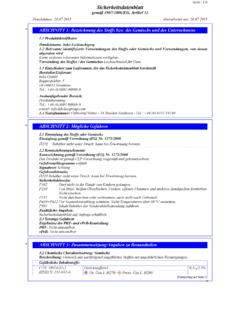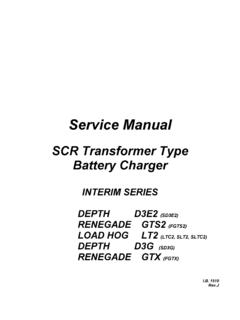Transcription of Safety Data Sheet - i&M Bauzentrum
1 Safety data Sheet SECTION 1: IDENTIFICATION OF THE SUBSTANCE/PREPARATION AND OF THE. COMPANY/UNDERTAKING. Product Name: DURACELL LITHIUM MANGANESE DIOXIDE BATTERIES. Product Identification: Lithium Manganese Dioxide Cells . Product Use: Energy Source SDS Date of Preparation: April 20, 2009. Product Designations: Battery Name/Size Duracell Designation Voltage IEC Designation Duracell CR-V3 CR-V3 3 CR-V3. Duracell 123 123A 3 CR17345. Duracell 223 223 6 CR-P2. Duracell 245 245 6 2CR5. Duracell CR2 CR2 3 CR17355. Duracell CP1 CP1 3. Duracell 28L 28L 6 2CR13252. Duracell 1/3N 1/3N 3 CR1108. Company Identification: EU Office Switzerland Office US Office Procter & Gamble UK. Procter& Gamble Duracell, a division of P&G. The Heights, Brooklands Switzerland SARL Berkshire Corporate Park Weybridge, Surrey Route de Saint-Georges 47 Bethel, CT 06801 USA. KT13 0XP UK 1213 Petit-Lancy, 1, Geneva, Telephone: 203-796-4000.
2 Telephone: +44-1-93-289-6000 Telephone: +41-58-004-6111. Emergency Phone Number: CHEMTREC 24-Hour Emergency Response Hotline: 703-527-3887. (United States of America). SECTION 2: HAZARDS IDENTIFICATION. Physical Appearance: Small cylindrical batteries. CAUTION: Battery can explode or leak if heated, disassembled, shorted, recharged, exposed to fire or high temperature or inserted incorrectly. Keep in original package until ready to use. Do not carry batteries loose in your pocket or purse. Keep batteries away from children. If swallowed, consult a physician at once. For information on treatment, call the NATIONAL BUTTON BATTERY. INGESTION HOTLINE, collect to the United States of America, day or night, at (202) 625-3333. Under certain misuse conditions and by abusively opening the battery, exposed lithium can react with water or moisture in the air causing potential thermal burns or fire.
3 EU Classification of Preparation: Not classified as a dangerous preparation. GMEL # Page 1 of 7. SECTION 3: COMPOSITION/INFORMATION ON INGREDIENTS. Chemical Name CAS Number EINECS Amount Classification Number Manganese Dioxide 1313-13-9 215-202-6 15-45% Xn, R20/22. 1,2-Dimethoxyethane 110-71-4 203-794-9 5-10% F, Repr Cat 2, Xn, R11, R19, R20, R60, R61. Propylene Carbonate 108-32-7 203-572-1 1-10% Xi, R36. Lithium 7439-93-2 231-102-5 1-5% C, F, R14/15, R34. Lithium Trifluoromethane 33454-82-9 251-528-5 0-5% Xi R36/37/38. Sulfonate Carbon Black 1333-86-4 215-609-9 0-5% None Ethylene Carbonate 96-49-1 202-510-0 0-5% Xi R36/37/38. Graphite 7782-42-5 231-955-3 0-5% None SECTION 4: FIRST AID MEASURES. General Advice: The chemicals and metals in this product are contained in a sealed can. Exposure to the contents will not occur unless the battery leaks, is exposed to high temperatures or is mechanically, physically, or electrically abused.
4 Eye Contact: If battery is leaking and material contacts the eye, flush thoroughly with copious amounts of running water for 30 minutes. Seek immediate medical advice. Skin Contact: If battery is leaking and material contacts the skin, remove any contaminated clothing and flush exposed skin with copious amounts of running water for at least 15 minutes. If irritation, injury or pain persists, seek medical advice. Inhaled: If battery is leaking, contents may be irritating to respiratory passages. Move to fresh air. If irritation persists, seek medical advice. Swallowed: If battery is swallowed seek immediate medical advice. Batteries lodged in the esophagus should be removed immediately since leakage, caustic burns and perforation can occur as soon as two hours after ingestion. If mouth area irritation or burning has occurred, rinse the mouth and surrounding area with tepid water for at least 15 minutes.
5 Do not give ipecac. Note to Physician: Published reports recommend removal from the esophagus be done endoscopically (under direct visualization). Batteries beyond the esophagus need not be retrieved unless there are signs of injury to the GI tract or a large diameter battery fails to pass the pylorus. If asymptomatic, follow-up x- rays are necessary only to confirm the passage of larger batteries. Confirmation by stool inspection is preferable under most circumstances. For information on treatment, telephone (202) 625-3333, collect to the United States of America, day or night. Potential leakage of dimethoxyethane, propylene carbonate and lithium trifluoromethane sulfonate. Dimethoxyethane rapidly evaporates. Do not give ipecac. SECTION 5: FIRE FIGHTING MEASURES. Fire and Explosion Hazards: Batteries may burst and release hazardous decomposition products when exposed to a fire situation.
6 GMEL # Page 2 of 7. Extinguishing Media: Use any extinguishing media that is appropriate for the surrounding fire. Special Fire Fighting Procedures: Firefighters should wear positive pressure self-contained breathing apparatus and full protective clothing. Fight fire from a distance or protected area. Cool fire exposed batteries to prevent rupture. Use caution when handling fire-exposed containers (batteries may explode in heat of fire). Hazardous Combustion Products: Thermal degradation may produce hazardous fumes of lithium and manganese; hydrofluoric acid, oxides of carbon and sulfur and other toxic by-products. SECTION 6: ACCIDENTAL RELEASE MEASURES. Notify Safety personnel of large spills. Irritating vapors and flammable may be released from leaking or ruptured batteries. Eliminate all ignition sources. Evacuate the area and allow the vapors to dissipate. Clean-up personnel should wear appropriate protective clothing to avoid eye and skin contact and inhalation of vapors or fumes.
7 Increase ventilation. Carefully collect batteries and place in an appropriate container for disposal. Remove spilled liquid with absorbent and contain for disposal. SECTION 7: HANDLING AND STORAGE. Avoid mechanical or electrical abuse. DO NOT short circuit or install incorrectly. Batteries may explode, pyrolize or vent if disassembled, crushed, recharged or exposed to high temperatures. Install batteries in accordance with equipment instructions. Replace all batteries in equipment at the same time. Do not carry batteries loose in a pocket or bag. Storage: Store batteries in a dry place at normal room temperature. SECTION 8: EXPOSURE CONTROLS/PERSONAL PROTECTION. The following occupational exposure limits are provided for informational purposes. No exposure to the battery components should occur during normal consumer use. Refer to specific country regulations for additional exposure limit information.
8 Chemical Name Exposure Limits Manganese Dioxide 0,5 mg/m3 TWA UK WEL. 0,5 mg/m3 TWA (inhalable) DFG MAK. 0,2 mg/m3 VL Belgium 0,2 mg/m3 TWA Denmark LV. 1,2-Dimethoxyethane None established Propylene Carbonate None established Lithium None established Lithium Trifluoromethane Sulfonate None established Carbon Black 3,5 mg/m3, 7 mg/m3 STEL UK WEL. 3,6 mg/m3 VL Belgium 3,5 mg/m3 TWA Denmark LV. Ethylene Carbonate None established Graphite 4 mg/m3 TWA UK WEL (respirable dust). 10 mg/m3 TWA UK WEL (inhalable dust). 1,5 mg/m3 TWA DFG MAK (respirable dust). GMEL # Page 3 of 7. 4 mg/m3 TWA DFG MAK (inhalable dust). 2 mg/m3 VL Belgium (respirable dust). Ventilation: No special ventilation is needed for normal use. Respiratory Protection: None required for normal use. Skin Protection: None required for normal use. Use butyl rubber gloves when handling leaking batteries. Eye Protection: None required for normal use.
9 Wear Safety goggles when handling leaking batteries. SECTION 9: PHYSICAL AND CHEMICAL PROPERTIES. Appearance and Odor: Batteries, labeled Duracell . Water Solubility: Insoluble Flash Point: 29 F (-2 C) (1,2-Dimethoxyethane). SECTION 10: STABILITY AND REACTIVITY. Stability: This product is stable. Incompatibility/Conditions to Avoid: Contents are incompatible with strong oxidizing agents. Do not heat, crush, disassemble, short circuit or recharge. Hazardous Decomposition Products: Thermal decomposition may produce hazardous fumes of lithium and manganese; hydrofluoric acid, oxides of carbon and sulfur and other toxic by-products. Hazardous Polymerization: Will not occur SECTION 11: TOXICOLOGICAL INFORMATION. Potential Health Effects: The chemicals and metals in this product are contained in a sealed can. Exposure to the contents will not occur unless the battery leaks, is exposed to high temperatures or is mechanically, physically, or electrically abused.
10 Eye Contact: Contact with battery contents may cause irritation. Skin Contact: Contact with battery contents may cause irritation. Inhalation: Inhalation of vapors or fumes released due to heat or a large number of leaking batteries may cause respiratory and eye irritation. Ingestion: Swallowing is not anticipated for larger batteries due to battery size. Smaller batteries may be swallowed. If battery is swallowed, seek immediate medical advice. Batteries lodged in the esophagus should be removed immediately since leakage, caustic burns and perforation can occur as soon as two hours after ingestion. Irritation to the internal/external mouth areas, may occur following exposure to a leaking battery. GMEL # Page 4 of 7. Acute Toxicity data : Manganese Dioxide: LD50 oral rat >3478 mg/kg 1,2-Dimethoxyethane: LDLo oral rat 1000 mg/kg, LCLo inhalation rat 63 g/m3/6 hr Propylene Carbonate: LD50 oral rat 29100 uL/kg; LD50 dermal rabbit >20 ml/kg; LC50 inhalation rat >5.








